

TALENT ACQUISITION
Associating the difference between Talent Acquisition and Recruitment
Terms “recruitment” and “talent acquisition” are often mistakenly referred to as the same thing. We try to help our customers understand the nuances between the two and adapting the hiring process accordingly to become less reactionary and increase the chance of talent to time. Therefore, it would be important at this point to point out the main differences.
Recruitment
Talent Acquisition
Instead of a linear process, talent acquisition is a cyclical approach that’s geared towards building relationships, anticipating future hiring needs, and creating a sustainable pool of candidates. It’s a more strategic approach that develops and nurtures a talent pipeline with a long-term view.
Now that we have defined the terms, here are the elements that differentiate talent acquisition from recruitment.

1. Planning and Strategy
Establishing a solid talent acquisition strategy requires HR to work more consultative in the organisation rather than part of a company. This can be very challenging and requires a good understanding of in-house processes along the value added chain. We work close together with your HR and Business Leaders in the different faculties to help assess short-, mid- and long-term goals carrying out deep assessment of both technological, process and hygienic factors and translate these into respective job specifications. We carry out a Skill Gap Analysis and help you generate a strategic work planning schedule. As this is cyclical, we help give you the tools to ensure that the process lives on.
2. Deep Specification
As pointed out in point one, Talent acquisition depends on understanding the different work segments within your organisation, as well as the different positions within those segments. Not only do you need a thorough understanding of your company’s inner workings, but you must also know the skills, experiences, and competencies that each position required to achieve sustainability when approaching and hiring your talent. Our staff has in-depth experience in multiple industries and across many technology chains. Using special assessments we also create a snapshot of your organisations culture. And let this flow into the recruitment process to ensure that all bases have been covered in the pre-screening and qualification of the candidate.
3. Employer Branding
Recruitment has become far more personal over the last 10 years, recruitment is marketing and many companies have not recognised this. We find ourselves in challenging times. The behaviour and expectations of the employer market is facing a radical change and organisations which choose to ignore the relevance of employer branding, will find themselves increasingly isolated. The biggest challenge is that employer branding is far more than recruiting, it channels in to every part of the organisation and especially among the Millennial generation, can signal a choice for or against you.
Therefore, brands are going beyond attracting consumers to attracting talent. Ensuring that your company’s brand is clear and attractive is the main element in talent acquisition. This involves fostering a positive image and company culture and establishing a good reputation based on quality products and services. A solid brand attracts top candidates while giving them a look inside at what it’s like to work for your company.
4. Talent Scouting and Management
Top talent comes from a variety of different channels. Within the talent acquisition process, you’re researching and recognising the different means from which candidates can be sourced. Once you’ve established contact with potential candidates, you have to maintain and build those relationships. All this is done with the understanding that most of these candidates will not fill positions right away, but rather down the line. We like to talk about Gold and Silver candidates. However, even candidates that do not seem to fit should not immediately be dismissed. It is easy to jump to conclusions, and we help you deal with avoiding this, thus expanding your talent pools for perhaps other segmentation areas for the future. We help show you best practices, even with the talent that you turn down, avoiding generic emails which detract from the quality of the applicant experience.
5. Performance Management
To create sustainability to your internal recruitment process, we help you identify KPIs, to analyse and track your advancement properly. The ultimate aim is for you to be enabled to continuously improve processes and optimise your decision-making ensuring that you are hiring top talents and inline with your employer branding are sticking to best practices, even with the candidates that you choose not to hire.
COACHING RECRUITERS ON EFFECTIVE ACTIVE SOURCING AND DIGITAL RECRUITING STRATEGIES IN OUR RECRUITING ACADEMY
